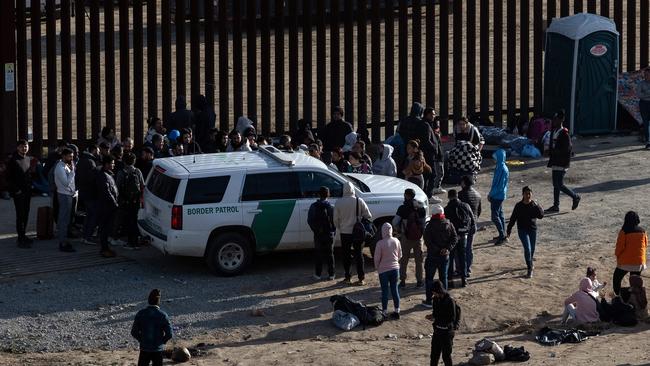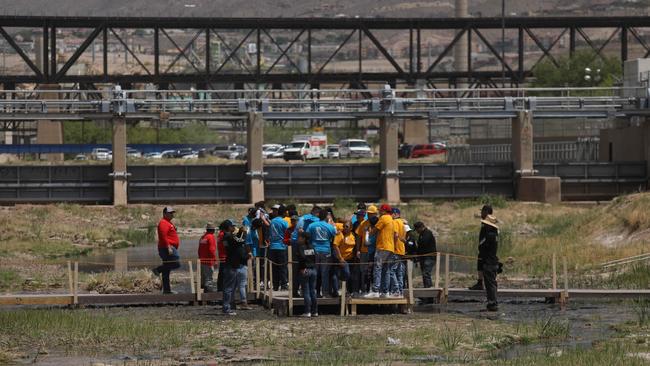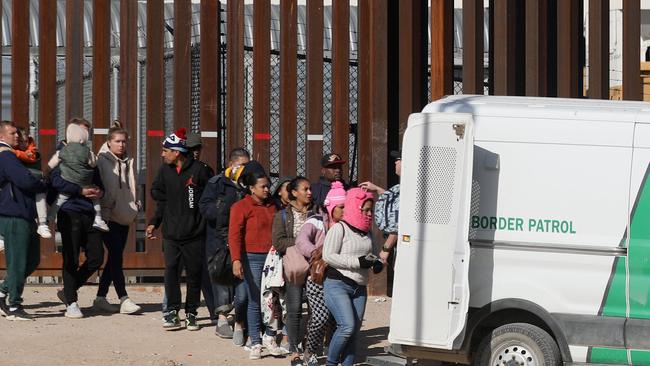Why the US stands to profit from southern border crisis
The influx of people is disruptive, divisive and burdensome, especially for southern border communities. But it’s not all bad in the long run for the US.

When Title 42, a rule in place since March 2020, expires on Friday some 13,000 asylum-seekers are expected to reach the US-Mexico border – around double the rate of April – putting the total number of so-called “encounters” for the 2023 fiscal year on track to exceed 2.4 million (the number that arrived in 2022).

In sum this means the equivalent of the entire population of Victoria will have lobbed on the US southern border over a three-year period by October 1. By comparison, the flow puts Australia’s “boat people” problem of the early 2010s, where annual arrivals numbered in the thousands, somewhat in perspective.
To be sure, the asylum-seeker influx strains local communities’ tolerance and public resources, and inevitably includes criminals, who bring illegal drugs, leading to the deaths of hundreds of hopefuls in the desert. But, despite the obvious tragedy of these deaths, the US stands to benefit from the enormous flow of arrivals, which is why the country’s politicians so often complain about the “border crisis” but do little to fix it.
Demography is destiny and a shrinking, ageing population is a harbinger of weakness. The human tsunami crashing over the US southern border isn’t only a vote of confidence in the US but a rarely acknowledged source of strength. For a start, the US economy is crying out for workers, with an unemployment rate of 3.4 per cent, the lowest since the 1960s.
But the benefit of outsized immigration, legal or not, is more than economic.
It wouldn’t be lost on Washington that the populations of America’s top two long-term competitors, China and Russia, are shrinking and ageing. Indeed, without the large Hispanic inflow the US would be facing the same embarrassing stagnation or decline as its biggest allies in Europe and Japan, with all the attendant fiscal, economic and creative problems that entails.
Since 2016 deaths of white Americans have outnumbered white births, reflecting the collapse in birth rates across the developed world. The deluge of migrants, who are younger than the average American, may well bolster America’s position as the number one global power for longer than analysts – long awestruck by the seemingly inevitable rise on China – might have expected.
In the short term, millions of new and illegal workers will depress American wages, at least for lower-skilled workers in hospitality and agriculture, for instance, but in the longer term the economy will adjust.
The US successfully absorbed immigrants at much greater rates in the late 19th century, when the US population was growing at around three times the pace – mainly through immigration – as it is now. The largely Hispanic, culturally conservative immigrants queuing up at the border for processing will assimilate as they have always done. “Everyone agrees our immigration system is outdated and badly broken,” Secretary for the Homeland Security Alejandro Mayorkas said last week in El Paso, Texas, noting the situation was “extremely challenging”. Mayorkas stressed the new Title 8 provisions in immigration law gave authorities all the power they needed to control the border.
But economic forces will prove more powerful, as they usually do.
President Joe Biden sent 1500 troops to the border last week to help local authorities, but this was merely a cosmetic decision to appear tough, as the 2024 presidential election looms. Moreover, the resources actually needed to stem the tide would be vastly greater.
If this unwanted level of immigration were such a disaster for the US, why has neither side of politics done anything about it for decades? In political terms, rapid immigration is very unpopular, even among immigrants, so governments cannot openly pursue it without courting trouble.
Just ask former UK prime minister Liz Truss after her fleeting administration unveiled a plan to drastically boost immigration, a prelude to her quick removal by terrified Tories in working-class seats.
The US is no different. Republicans have made hay with surging arrivals, deliberately sending immigrants by bus and even plane to rich Democrat enclaves to adoring cheers from their political base.
Donald Trump made a wall along the Mexican border the centrepiece of his election campaign in 2016, but over four years ended up extending the existing wall very little, though without much congressional support.
As president in the 2000s George W. Bush tried hard to grant legal status to more than 10 million immigrants who had arrived illegally. It’s almost as if both sides of politics, and the hard heads in the upper echelons of the US bureaucracy, tacitly understand a rapidly growing population is a source of strength for the US but can’t say so openly.
Australia is in a similar but different position, being a highly desirable place to live but without a “southern border” to facilitate population growth at a faster rate than the political class would be willing to publicly endorse.

Whatever the pros and cons of the 650,000 immigrants expected to arrive in Australia over the next two years, the political blowback will be toxic.
“Let me be clear. Our border is not open and will not be open after May 11th,” Mayorkas said. It most likely will be, though, and continue to be even if Republicans win the White House in 2024.
The influx of people is disruptive, divisive and burdensome, especially for southern border communities. But it’s not all bad in the long run for a nation whose leaders would like to remain number one.








The US political class is in a panic over an impending surge of illegal immigrants – from already record levels – as a pandemic-era rule allowing authorities to expel arrivals on health grounds is poised to lapse.